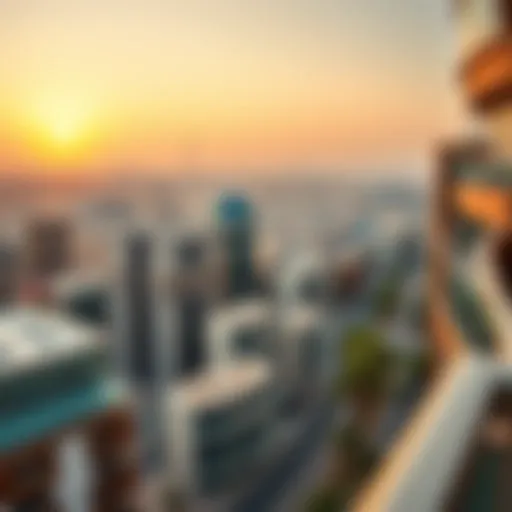Architectural Insights on Sheikh Zayed Road Buildings
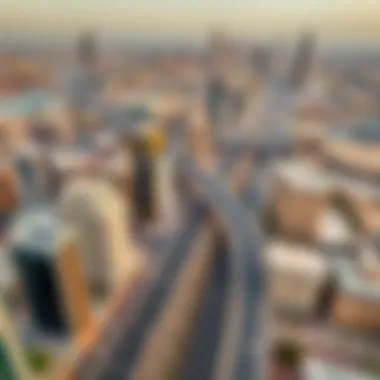

Intro
Sheikh Zayed Road is not just a road; it's a symbol of Dubai's rapid transformation from a sleepy trading port to a bustling metropolis. Stretching over 55 kilometers, this road is flanked by some of the most iconic buildings in the world. Each structure represents a unique blend of innovation, opulence, and bold architectural vision. In this exploration, we will delve into the stories behind these towering edifices, examining their design philosophies as well as their significance in Dubai's overall urban narrative.
More than simply aesthetics, the buildings along Sheikh Zayed Road hold immense value in terms of economic impact and real estate dynamics, which are crucial for potential investors and homebuyers alike. As we journey through our analysis, we will touch on how these grand designs contribute to Dubai's identity—drawing international acclaim and local pride.
Market Insights
Current Trends in Dubai Real Estate
Dubai's real estate market has often been likened to a rollercoaster ride, with its ups and downs creating excitement and trepidation alike. Recently, a noticeable shift is evident. The demand for luxury apartments and commercial spaces along Sheikh Zayed Road has surged, spurred by a growing influx of expatriates and foreign investors seeking to make their mark in this glittering city. High-end developments, such as the Burj Khalifa and the Dubai Marina, exemplify the aspiration for luxury living.
In addition to this premium demand, there's been a palpable interest in sustainable and smart buildings. With Dubai positioning itself as a global leader in smart city initiatives, new projects are increasingly integrating eco-friendly technologies, appealing to environmentally conscious buyers and aligning with the UAE’s vision for sustainable growth.
Market Forecast and Predictions
Forecasting the future of Dubai's real estate market, especially along this pivotal highway, reveals promising signs. Analysts suggest that property prices may experience a gradual increase, driven by the ongoing Expo 2020 events and the anticipated surge in tourism that follows. With robust job creation in sectors such as technology and finance, the multifaceted appeal of Sheikh Zayed Road buildings continues to grow.
Furthermore, historical data suggests that properties in prime locations retain their value better than those on the outskirts. Therefore, investing in real estate along Sheikh Zayed Road could be a lucrative venture. The combination of mixed-use developments—where commercial, residential, and leisure spaces coexist—is a trend that's likely to become more prevalent.
"In real estate, location is the golden ticket, and there’s no better ticket than the iconic Sheikh Zayed Road"
Buying and Selling Guide
Steps to Purchase Property in Dubai
Buying a property in Dubai, particularly along Sheikh Zayed Road, may seem daunting for first-time investors. Here are some basic steps to simplify the process:
- Research the Market: Knowledge is power. Familiarize yourself with current prices and trends in the area.
- Choose a Reputable Agent: Connecting with a licensed real estate agent can provide invaluable insights and access to listings.
- Visit Properties: Never buy sight unseen. Schedule visits to gauge the actual living conditions and ambience.
- Secure Financing: Determine your budget and explore mortgage options with local banks or lenders.
- Make an Offer: Once you find a suitable property, make a formal offer through your agent.
- Conclude the Deal: After negotiations (if any), finalize the contract and handle the necessary paperwork.
Essential Tips for Sellers
For those looking to sell property along Sheikh Zayed Road, the stakes are equally high. Here are crucial tips:
- Enhance Curb Appeal: A dazzling first impression is key. Make small renovations or updates to boost attraction.
- Set a Competitive Price: Conduct a comparative market analysis to price your property competitively without undervaluing.
- Market Aggressively: Utilize both online platforms and traditional advertising methods to reach potential buyers.
- Be Flexible with Showings: Accommodate potential buyers’ schedules—this may make all the difference in closing a sale.
In wrapping up this insightful exploration, we must recognize that Sheikh Zayed Road is not merely a thoroughfare but a vibrant community fueled by dreams and aspirations.
As we proceed through the next sections, we will continue to uncover the architectural wonders and economic implications that shape this prestigious stretch of Dubai.
Prologue to Sheikh Zayed Road
Sheikh Zayed Road, a name that reverberates through the corridors of Dubai's urban development, stands as both a lifeline and a canvas for the aspirations of a city. The road is not just a means of transportation but a showcase of architectural splendor and economic vigor. In this section, we will explore its significance, peeling back the layers of history, planning, and purpose that make this thoroughfare an essential aspect of Dubai's identity.
Historical Context
Understanding the historical underpinnings of Sheikh Zayed Road provides insights into the rapid evolution of Dubai from a modest fishing village to a global powerhouse. Initiated in the early 1970s, the road was named after Sheikh Zayed bin Sultan Al Nahyan, the founding father of the United Arab Emirates. Originally intended as a strategic connector between the Emirates, it laid the groundwork for modern urban planning and economic growth. The development of this road coincided with the UAE's oil boom, which brought not only wealth but also a substantial influx of expats, leading to a surge in demand for infrastructure.
Over the years, Sheikh Zayed Road has matured into a bustling artery filled with high-rises, commercial centers, and luxury hotels. This evolution reflects not just changing architectural styles but also shifts in societal needs, showcasing adaptability in design and functionality. Timeline milestones include the completion of notable structures such as the Burj Khalifa and the Emirates Towers, both of which have become synonymous with Dubai's skyline. From initial conception to the cutting-edge heights of today, this road has a narrative enmeshed with that of the city itself.
Sheikh Zayed Road's Importance
When it comes to urban landscapes, Sheikh Zayed Road isn’t just another stretch of asphalt; it’s the heartbeat of Dubai's economic activity.
- Commercial Hub: The road is a crucial zone for businesses, hosting major shopping malls, hotels, and corporate offices. These establishments play a pivotal role in the economy, generating job opportunities and fostering a vibrant marketplace.
- Cultural Significance: Beyond commerce, the road accentuates the cultural fabric of Dubai. It connects key venues like the Dubai World Trade Centre and the Dubai International Convention Centre, hosting global events and conferences that draw visitors from around the world.
- Tourism Magnet: With attractions dotted along its length, it serves as a magnet for tourists. The Burj Khalifa alone attracts millions, along with the various dining and entertainment options.
- Urban Planning Paradigm: Sheikh Zayed Road embodies visionary urban planning principles. It encourages mixed-use developments that blend residential, commercial, and recreational spaces, promoting community engagement while maintaining a modern aesthetic.
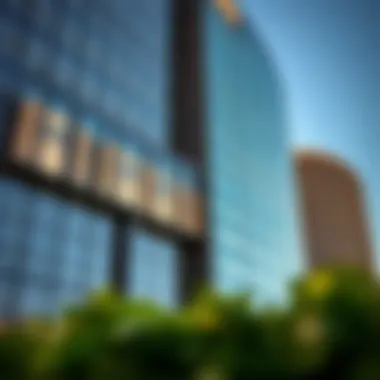

In summary, Sheikh Zayed Road is a crucial spine of urban connectivity, economic growth, and cultural exchange in Dubai. Its transformation over the decades reflects the city’s ambitions and serves as a testament to successful urban planning. Further exploration of the iconic buildings along this road will highlight the architectural prowess that complements its economic significance.
Iconic Buildings Along the Road
The structures that line Sheikh Zayed Road are not merely buildings; they are milestones of architectural innovation and cultural expression. These iconic buildings serve as a tangible representation of Dubai's rapid growth and its ambition to establish itself as a global hub. Each structure on this thoroughfare tells a unique story, contributing to the collective urban identity that draws millions of visitors and investors alike.
Burj Khalifa
Architectural Significance
The Burj Khalifa stands tall as not just the world’s tallest building but also a testament to cutting-edge engineering and artistic vision. Designed by Adrian Smith of Skidmore, Owings & Merrill, the tower’s Y-shaped design allows for efficient use of space while providing stunning views of the surrounding area. One of the most notable aspects of the Burj Khalifa's architecture is its exterior cladding, made from reflective glazing, which allows the sun to bounce off its surface, blending seamlessly into the sky. This design choice is not only aesthetically pleasing but also plays a crucial role in minimizing energy consumption by maximizing natural light.
When assessing its architectural significance, it’s easy to see how Burj Khalifa became an icon for both the city and the world. Visitors hail it as a popular tourist destination due to its observation deck, which is one of the highest in the world. Here, one can behold the mesmerizing urban landscape of Dubai, full of life and modernity. The tower's structural innovations have paved the way for future skyscrapers around the globe, redefining what is possible in modern architecture.
Impact on Skyline
The impact of the Burj Khalifa on Dubai’s skyline is monumental. Its presence transforms the horizon into a striking silhouette, which is often featured in promotional material for the city. This verticality draws the eyes upward, creating a sense of awe while showcasing the ambitions of Dubai’s architectural landscape. Its unique design has become a reference point for many other modern constructions in urban centers worldwide. The neon lights and evening illuminations enhance its majesty, providing a dynamic element to the skyline as day turns into night.
While the Burj Khalifa dominates the skyline, it also serves as a catalyst for surrounding development. Other buildings have emerged as complementary structures, creating a visual dialogue within the skyline. However, some critiques do suggest that such towering structures can overshadow more historical edifices, sparking debates about architectural balance. Still, the Burj Khalifa remains an unparalleled benchmark of ambition.
Dubai World Trade Centre
Functionality and Design
The Dubai World Trade Centre was one of the first skyscrapers to grace Sheikh Zayed Road, and it remains pivotal to the business landscape in the region. Its design emphasizes functionality, with expansive exhibition halls and conference rooms that are equipped with state-of-the-art facilities. This building facilitates international trade and business exchanges, fostering growth in a competitive economic environment.
Its structure incorporates a design aesthetic that balances modernity with a touch of cultural significance. The building's facade merges traditional elements with contemporary style, creating a unique identity within Dubai’s rapidly evolving skyline. This functionality is complemented by ease of access to major transport routes, making it an prime choice for businesses looking to establish themselves in the area.
Cultural Importance
Beyond commercial viability, the Dubai World Trade Centre holds a cultural significance that cannot be overlooked. It often hosts international exhibitions and trade events, acting as a focal point for cross-cultural interactions. By promoting trade relations, it fosters a spirit of collaboration among nations. The Centre has become a symbol of Dubai's progressive aspirations, reflecting its commitment to being a major player on the world stage.
Moreover, its involvement in community events and festivals adds to its cultural footprint, ensuring that it remains a central hub for various congregations year-round. Its ability to engage with both local and global entities marks it as an essential institution for cultural and economic exchanges.
Emirates Towers
Mixed-Use Space
The Emirates Towers epitomize the concept of mixed-use development, housing offices, a hotel, and retail spaces under one roof. The design embraces a dual tower concept with sleek glass facades, offering a modern take on urban living and functionality. Notably, it has been recognized for its integration of commercial and leisure spaces, effectively enhancing the utility of the building for both occupants and visitors.
This blend of functionality allows for a seamless experience—people can work, dine, and shop without stepping outside. Such mixed-use spaces have become incredibly popular in urban development because they encourage walkability and community interaction, reducing reliance on transportation and promoting a healthier lifestyle.
Sustainable Features
Sustainability has become a prominent focal point within architectural practices, and the Emirates Towers stand as a testament to this ethos. The development incorporates a range of sustainable features, including energy-efficient systems and water-saving technologies. The building's design maximizes natural light and incorporates landscaping that contributes to biodiversity in an urban setting.
The commitment to sustainable development defines not only how the Emirates Towers function but also influences broader urban development trends. It serves as a model for future projects looking to minimize environmental impact while maximizing usability. Despite the benefits, maintaining such sustainable systems can also pose challenges, particularly concerning maintenance and operational costs, which must be managed effectively to ensure long-term success.
In summary, the towering structures of Sheikh Zayed Road are not merely architectural feats; they are vital components of Dubai’s identity. The Burj Khalifa, Dubai World Trade Centre, and Emirates Towers stand sentinel over the city, each contributing uniquely to its narrative and growth. As we delve further into this exploration, one must recognize how each building’s design and significance layers the overall architectural tapestry of Dubai.
Architectural Styles
The architectural styles that grace Sheikh Zayed Road offer a fascinating glimpse into the evolution of design and urban planning in Dubai. Each style tells its own story, reflecting cultural influences, technological advancements, and the visionary aspirations of the emirate. This section is critical not just for understanding individual buildings, but for grasping the overarching narrative of how Dubai positions itself on the global stage.
Contemporary Design Trends
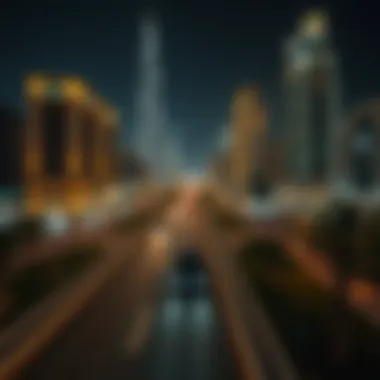

Contemporary architecture along Sheikh Zayed Road showcases clean lines, open spaces, and a harmony with the environment. Sleek glass facades dominate the skyline, creating a modern aesthetic that resonates with the aspirations of a rapidly developing urban area. Buildings like the Opera District and the Dubai Frame exemplify these trends, merging functionality with elegant design. City planners have embraced natural light and sustainable materials, reflecting a broader movement towards environmental awareness. For investors and developers, embracing these contemporary elements isn't just a nod to style; it's a significant factor in attracting businesses and residents alike. The integration of state-of-the-art technology, from green roofs to energy-efficient systems, is another hallmark of these designs that contributes to long-term economic viability.
Postmodern Architecture
Postmodern architecture along Sheikh Zayed Road serves as a fascinating counterpoint to the stark minimalism of contemporary designs. Characterized by eclectic forms and vibrant colors, buildings like the Jumeirah Emirates Towers break traditional molds, creating eye-catching silhouettes that stand out against a backdrop of modernity. This style thrives on irony and playfulness, often incorporating historical references and local culture into its designs.
The significance of postmodern architecture lies in its ability to evoke a sense of place and identity. For homebuyers and residents, these structures offer a unique blend of nostalgia and innovation, forging a connection to Dubai's rich cultural tapestry while embracing the future. The intricate features of these buildings can also enhance property values, making them particularly appealing to investors seeking distinctive assets in the real estate market.
Integration of Art and Architecture
The intersection of art and architecture is most vividly observed along Sheikh Zayed Road, where buildings are not just functional structures but artistic statements. This integration can be seen in projects that feature public art installations and collaborative design efforts that engage local artists. The Dubai Design District, in particular, has become a hotspot for creative expression, where every corner might surprise you with a mural or an avant-garde sculpture.
The dialogue between art and architecture enhances the overall urban experience and draws tourists and residents alike into a multifaceted cultural landscape.
This synergy not only beautifies the environment but also fosters community engagement. For analysts and developers, recognizing the value of artistic integration can be crucial for future projects—blending aesthetics with functionality can lead to enhanced marketability and consumer interest. A space that inspires creativity is a magnet for innovation, pointing to a promising trajectory in real estate growth along this iconic thoroughfare.
For additional insights, visit Wikipedia and check out the relevant sections on urban planning and architecture. You may also browse articles on Britannica for historical context, as well as engaging discussions on Reddit.
As a final note for investors and developers, paying attention to these architectural nuances will not just enhance your projects but also contribute to the narrative of Dubai as a futuristic metropolis.
Economic Impact of Sheikh Zayed Road Structures
Sheikh Zayed Road serves as a spine of development in Dubai. Its buildings are not merely architectural wonders; they symbolize economic vitality and urban dynamism. The economic impact of these structures extends into various realms, such as real estate dynamics, job creation, and overall growth in the Emirate. Understanding this impact helps stakeholders—be it investors, homebuyers, or urban planners—grasp the significance of their investments.
Real Estate Market Dynamics
Commercial vs Residential Properties
One of the most noteworthy aspects of Sheikh Zayed Road is its balance of commercial and residential properties. Commercial spaces, such as sleek office towers and retail centers, typically attract businesses looking to establish a foothold in a competitive market. In contrast, residential buildings provide living spaces for the workforce powering these enterprises.
Key Characteristics: Commercial properties on Sheikh Zayed Road are often designed with high visibility and accessibility. They tend to offer amenities that appeal to businesses, like meeting spaces and proximity to transport links. On the other hand, residential properties are geared toward comfort, offering features that cater to families and individuals seeking quality living.
Unique Features: The skyscrapers along the road often blend residential and commercial usages. For instance, the Emirates Towers houses both office spaces and a five-star hotel, creating an ecosystem that benefits from the foot traffic from one domain to the other.
Advantages and Disadvantages: Each type has its pros and cons. Commercial properties can generate substantial rents from businesses, often yielding better returns. However, they can also face fluctuations due to economic shifts impacting businesses. Residential properties, while usually seen as safer investments due to consistent demand, may offer lower yield returns compared to commercial spaces.
Investment Trends
Investment trends on Sheikh Zayed Road present a fascinating dimension. Over the years, this area has witnessed a boom in investments across both sectors—commercial and residential. These trends give potential investors and developers much to ponder when considering where to put their money.
Key Characteristics: Investors are increasingly favoring mixed-use developments that combine commercial, residential, and retail spaces. The allure lies in their capacity to attract a broader audience and maintain continual foot traffic.
Unique Features: These mixed-use developments often incorporate sustainable design, tapping into the growing market of environmentally conscious consumers. For instance, Zaha Hadid's Al Ain Road development includes state-of-the-art green technologies that appeal to modern sensibilities while also being functional spaces.
Advantages and Disadvantages: The primary advantage of such investments is their potential to offer better returns by serving multiple needs—retail can support office spaces, while residential units ensure comfort for employees. Conversely, the downside may include higher initial costs and complexities in development due to the various needs that such spaces must meet.
Job Creation and Economic Growth
The buildings along Sheikh Zayed Road don't just shape the skyline; they're critical to job creation. As companies establish themselves in this prominent area, they require personnel, thus creating direct and indirect employment opportunities. This influx of jobs fosters economic growth, further solidifying Dubai's standing as a leading global city.
The spillover effects are significant. For example, the staff needed to run large commercial properties, alongside service providers such as cleaner, maintenance, or even food vendors, stimulate local economies. Moreover, the emerging tech sector has begun to see an increase in transactions and operations along Sheikh Zayed Road, leading to a boosted demand for skilled professionals in those fields.
Regulatory Framework Influencing Development
Understanding the regulatory framework governing developments along Sheikh Zayed Road is paramount for anyone looking to navigate the complex landscape of Dubai's real estate and architectural evolution. This framework molds the very fabric of what gets built, how it interacts with its surroundings, and what standards it must meet. It's not just about the towers that scrape the sky; it's about the thoughtful design and planning that ensures finance, safety, and sustainability go hand in hand.
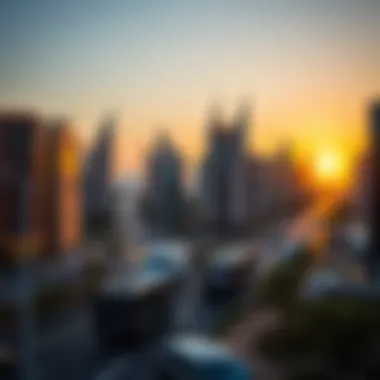

The regulations serve multiple purposes: promoting orderly development, protecting the environment, and ultimately ensuring a thriving urban environment conducive to business and lifestyle. As the heart of Dubai's commercial pulse, Sheikh Zayed Road needs to balance expansion with these critical regulatory considerations.
Zoning Laws
Zoning laws in Dubai dictate how land can be used and what structures can be built in specific areas. These regulations influence everything from building height and density to the functionalities of the buildings. Here's why zoning laws are particularly important:
- Land Use Designations: Certain areas along Sheikh Zayed Road are designated for commercial use, while others may be mixed-use or residential. This designation determines not only who can build where but also what kind of businesses may thrive in that zone.
- Density Restrictions: Zoning laws help control how densely structures can be packed together. Right along Sheikh Zayed Road, you'll find high-rise office buildings, hotels, and residential apartments, all dictated by these laws. Without proper density oversight, the area could easily become congested, undermining its appeal.
- Community Impact: These regulations also help maintain a balance between business and quality of life for residents. Noise pollution, traffic, and infrastructure wear and tear are some concerns that zoning aims to address.
When changes need to occur, public hearings and community feedback can frequently influence zoning law adjustments, making the community’s voice heard in development decisions.
Building Codes and Standards
Building codes and standards are the governing principles that ensure structures are safe, durable, and accessible. Understanding these codes is critical for anyone involved in real estate or development along this iconic road:
- Safety Regulations: Codes typically outline requirements related to structural integrity, fire safety, and emergency access. Given the height and scale of many buildings on Sheikh Zayed Road, adherence to these codes is vital for the safety of occupants and the public.
- Sustainability Practices: Increasingly, building codes are embracing sustainability measures. This includes energy efficiency standards, waste management protocols, and the use of recyclable materials. As Dubai aims for a greener future, these codes are expected to evolve to enforce even stricter environmental standards.
- Innovation in Architecture: The intersection of technology and building standards allows for innovative designs that can be both functional and aesthetically pleasing. This aspect is especially visible in contemporary buildings that line Sheikh Zayed Road, showcasing a blend of artistry and compliance with standards.
"Building codes may seem like a dull subject, but they are the unsung heroes that keep our structures standing tall and our cities breathing smoothly."
Furthermore, the consistent application of these building codes and standards aims to not only elevate the design ethos of structures but also to enhance the reputation of Sheikh Zayed Road as a global architectural hub.
In summary, the regulatory framework shaping the development along Sheikh Zayed Road is not only crucial for the current state of the area but also essential for planning its future. Investors, homebuyers, agents, and developers must grasp these critical components to ensure their projects align with legal standards and community aspirations.
Future Trends in Development
Exploring the future trends of development along Sheikh Zayed Road is crucial for understanding how this pivotal thoroughfare will shape the urban landscape and contribute to Dubai’s continuing evolution. With its ever-changing skyline and vibrant economy, there lies a convergence of architecture, technology, and environmental necessity. The significance of these trends is multifaceted, affecting everything from real estate valuations to the daily lives of residents. Companies and investors alike are keenly focused on how to align their aspirations with these future developments to stay competitive and relevant.
Sustainability Initiatives
Sustainability is emerging as a cornerstone of architectural innovation along Sheikh Zayed Road. As environmental concerns gain traction globally, Dubai stands at the forefront of embedding green principles into its fabric. New projects increasingly focus on renewable energy sources, waste reduction, and water conservation.
Some noteworthy initiatives include:
- Building Designs: Many architects are adopting designs that enhance natural light, reducing dependency on artificial lighting. For instance, facades made of reflective glass not only create an aesthetic appeal but help in maintaining energy efficiency.
- Vertical Greenery: Incorporating green walls and terraces not only boosts biodiversity but helps in cooling buildings naturally — a necessity in the desert climate.
- Smart Landscaping: Using native plants that require minimal irrigation is becoming more common, alongside the introduction of systems that recycle greywater for landscaping purposes.
Understanding these initiatives is vital for investors and developers as these elements can significantly increase property appeal and market demand.
Technological Innovations
Technological advancements are also propelling the future of development on Sheikh Zayed Road. These innovations not only streamline construction processes but enhance the functionality and livability of buildings. Key trends in technology include:
- Smart Building Technologies: Buildings are increasingly equipped with smart systems for heating, ventilation, and lighting, allowing for real-time monitoring and adjustments based on occupancy.
- Digital Twins: This technology creates a virtual replica of physical buildings, allowing for extensive analysis and optimization of operational efficiency, climate response, and security measures.
- Blockchain Applications: Real estate transactions are witnessing a shift with blockchain technology simplifying the process, improving transparency, and reducing fraud risk.
As these technologies emerge and gain traction, they are becoming critical considerations for stakeholders involved in property investment, management, and ownership.
As designed cities move towards sustainability and modernization, Sheikh Zayed Road stands as a beacon of future developments rooted in innovation and ecological balance.
Closure
The conclusion of our exploration regarding the buildings along Sheikh Zayed Road is critical in understanding the broader implications of architectural design in urban environments. It serves as a capstone, summarizing the intricate tapestry of innovation, cultural identity, and economic significance that these landmarks embody.
Summarizing the Architectural Landscape
The architectural landscape of Sheikh Zayed Road is diverse, showcasing an assortment of styles that range from traditional Arab aesthetics to modernist feats of engineering. Each building tells a unique story, echoing the aspirations of Dubai and its vision for the future. For instance, the Burj Khalifa, standing as the tallest building in the world, not only represents an architectural milestone but also symbolizes the audacity of the emirate's ambitions.
In addition, properties like the Dubai World Trade Centre and the Emirates Towers highlight the blend of functionality and creativity, where commercial objectives meet cutting-edge design. The landscape is dotted with high-rise buildings, creating a skyline that is not only visually striking but also a hub for business and tourism. The careful integration of aesthetic appeal with practical design ensures that these structures are not just landmarks, but vital components of Dubai's economy.
The Significance of Sheikh Zayed Road in Urban Dubai
Sheikh Zayed Road is more than just a thoroughfare; it is the lifeblood of urban Dubai, driving the economic engine of the city. As one of the most important arteries in the UAE, it connects vital districts, making it a prime location for real estate development and investment. The concentration of iconic buildings along this road enables investors and stakeholders to capitalize on the high demand for commercial and residential space.
Furthermore, Sheikh Zayed Road serves as a beacon for global talent. The presence of multinational corporations and luxurious residential options attracts a diverse population, fueling economic growth and cultural exchange. It epitomizes the modern urban experience – a place where business and leisure coexist seamlessly.



